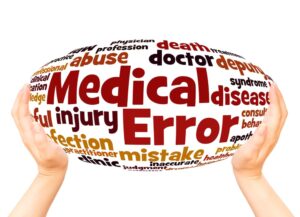What Is the Average Settlement for a Medical Malpractice Claim?
Gregg Hollander | July 4, 2024 | Medical Malpractice

Medical malpractice occurs when a healthcare provider behaves negligently or irresponsibly in some way. Common types of malpractice include misdiagnoses, botched medical procedures, and medication errors.
If you suffered a medical complication due to a healthcare provider’s negligence, you have legal options available. Specifically, a medical malpractice attorney can file a claim with the negligent healthcare provider’s insurance company.
When it comes to settling a medical malpractice claim, there is no “average” amount. Rather, the total compensation you receive will depend upon the extent of your medical complications, the circumstances surrounding the malpractice incident, and other case-specific factors. A skilled medical malpractice lawyer will aggressively negotiate with the insurance company on your behalf or litigate your case to a resolution in the state court system.
Common Types of Medical Malpractice Claims
Medical malpractice claims are legal actions by patients who believe they have suffered harm due to a healthcare provider’s or medical facility’s negligence. These claims typically fall into several common categories:

- Misdiagnosis or Delayed Diagnosis – This type of malpractice claim occurs when a doctor fails to diagnose a patient’s condition correctly or does so too late, resulting in a lack of necessary treatment or incorrect treatment. This can lead to worsened conditions or even death. For example, misdiagnosing a heart attack as indigestion can prevent a patient from receiving life-saving interventions.
- Medication Errors – Medication errors involve the incorrect prescription, dosage, or administration of drugs. This can happen due to poor communication, inadequate knowledge of a patient’s medical history, or confusion about drug names. Medication errors can lead to adverse reactions, ineffective treatment, or overdose.
- Surgical Errors – Surgical errors include performing surgery on the wrong body part, leaving surgical instruments inside the patient after a procedure, or causing unintentional damage to other organs during the procedure. Such mistakes can result in severe complications, prolonged recovery times, and additional surgeries.
- Birth Injuries – Birth injuries can affect both the mother and the baby and often arise from negligence during prenatal care or delivery. Common examples include failing to monitor fetal distress, improper use of delivery instruments like forceps, and not performing a necessary cesarean section in time. These mistakes can cause long-term disabilities or death.
- Anesthesia Errors – Errors related to anesthesia are particularly dangerous because they can quickly become life-threatening. Examples include giving too much or too little anesthesia, failing to monitor vital signs, or not considering the patient’s allergies and medical history. Anesthesia errors can lead to brain damage, paralysis, or death.
- Failure to Treat – This occurs when a doctor correctly diagnoses a condition but fails to recommend or provide the necessary medical treatment. It can happen due to understaffing, overworked medical personnel, or poor communication among the healthcare team. Failing to treat can lead to progression of the illness and preventable complications.
Common Complications that May Result from Medical Malpractice
Medical malpractice can lead to various types of complications, ranging from injuries to severe illnesses. These complications can arise due to negligence or errors by healthcare providers and can have long-lasting effects on patients.

- Infections – One common complication is infection. Infections can occur if surgical instruments are not properly sterilized or if there is poor hygiene in the medical facility. These infections can be minor or severe, leading to prolonged hospital stays, additional treatments, or even life-threatening conditions like sepsis.
- Organ Damage – Surgical errors can result in accidental damage to internal organs. For instance, a surgeon may accidentally cut or puncture an organ, leading to internal bleeding, loss of organ function, or the need for additional surgeries. Organ damage can cause chronic pain and other long-term health issues.
- Medication Reactions – Incorrectly prescribed medications or wrong dosages can cause adverse drug reactions. Patients may suffer from allergic reactions, overdoses, or harmful drug interactions. These reactions can range from mild rashes to severe conditions like kidney failure or respiratory problems.
- Nerve Injuries – Nerve damage can occur during surgeries or other medical procedures. This can happen if a nerve is accidentally cut, stretched, or compressed. Nerve injuries can lead to chronic pain, loss of sensation, or paralysis in affected areas, severely decreasing a patient’s quality of life.
- Birth Defects and Injuries – Medical negligence during childbirth can result in birth defects or injuries. For example, improper use of forceps or failure to perform a timely cesarean section can cause physical injuries to the baby, such as broken bones or brain damage. These complications can result in long-term disabilities or developmental issues.
- Anesthesia Complications – Errors in administering anesthesia can also lead to serious complications. Patients may experience anesthesia awareness (waking up during surgery), allergic reactions, or respiratory problems. In severe cases, improper anesthesia management can result in brain damage or death.
- Heart Attacks and Strokes – Misdiagnosis or delayed diagnosis of critical conditions like heart disease can lead to heart attacks or strokes. If symptoms are not recognized and treated promptly, the damage to the heart or brain can be significant and irreversible, potentially leading to long-term disability or death.
- Mental Health Issues – Beyond physical injuries, medical malpractice can also cause psychological harm. Patients may suffer from anxiety, depression, or post-traumatic stress disorder (PTSD) due to their experiences.
How to Prove a Medical Malpractice Claim or Lawsuit
To succeed in a medical malpractice claim, a patient must prove several legal elements, including all of the following:
- Duty of Care – The patient must show that the healthcare provider owes them a legal duty of care. This means there was a doctor-patient relationship where the provider agreed to diagnose or treat the patient. This element is usually straightforward, as the existence of medical records can prove the relationship.
- Breach of Duty – Next, the patient must demonstrate that the healthcare provider breached this duty of care by failing to act as a competent professional would under similar circumstances. This involves showing that the provider’s actions (or inactions) deviated from accepted medical standards. Expert testimony is often required here, where another medical professional explains how the care given fell short of what is expected.
- Causation – The patient must then link the breach of duty directly to the injury or harm they suffered. This means proving that the provider’s negligence caused the injury – not some other factor. Causation can be challenging to establish, as the patient must show that the harm would not have occurred if the provider had adhered to proper medical standards. Medical experts play a crucial role in explaining this connection.
- Damages – Finally, the patient must establish that they suffered actual harm or damages as a direct result of the provider’s negligence. Damages can be physical, such as injury or illness, as well as emotional, like pain and suffering. They can also be financial, including medical bills, lost income, and future care costs. The patient must provide evidence of these damages, which can include medical records, bills, and testimony about the effects on their life.
To prove these elements, an experienced medical malpractice attorney can:
- Gather evidence, including all relevant medical records, bills, and documentation related to the care received
- Work with medical experts who can review the case and provide testimony on how the standard of care was breached and how it caused harm
- File a complaint with the court outlining the allegations and supporting evidence
- Exchange information and evidence through discovery – including depositions, where witnesses are questioned under oath
By proving these elements, an injured patient can establish a valid medical malpractice claim and potentially receive compensation for their injuries and losses.
Factors that Affect the Amount of a Medical Malpractice Settlement Offer
When it comes to medical malpractice claims, there is no such thing as an “average” settlement offer. Rather, the amount of a settlement offer can vary widely based upon several factors, including all of the following:
- Severity of the Injury – The more severe the injury, the higher the potential settlement amount. Serious injuries that result in long-term disability, significant pain, or substantial medical expenses typically lead to larger settlements.
- Clear Evidence of Negligence – If there is strong, clear evidence that the healthcare provider was negligent, it increases the likelihood of a higher settlement. Solid evidence can include medical records, expert testimony, and witness statements.
- Effects on the Patient’s Quality of Life – The degree to which the injury affects the patient’s quality of life is another critical factor. If the injury prevents the patient from working, enjoying daily activities, or requires ongoing medical care, the settlement amount may be higher to compensate for these losses.
- Medical Expenses – The actual and anticipated future medical expenses resulting from the malpractice are significant factors. Higher medical costs generally lead to higher settlement offers to cover current and future treatment needs.
- Lost Income and Earning Capacity – If the injury causes the patient to miss work or reduces their ability to earn income in the future, these economic losses are considered. Compensation may cover lost income and the loss of future earning potential.
- Pain and Suffering – Non-economic damages like pain and suffering are also considered. These are more subjective and can vary greatly depending on the case’s specifics and how the injury affects the patient’s mental and emotional well-being.
- Legal and Procedural Factors – The legal environment – and whether the case is likely to go to trial – can also influence settlement amounts. Cases that are more likely to succeed in court may receive higher settlement offers to avoid a trial.
Patients may be eligible for different types of compensation, including:
- Economic Damages – These cover tangible financial losses such as medical bills, rehabilitation costs, and lost income. They can also include future medical expenses and loss of earning capacity.
- Non-Economic Damages – These compensate for intangible losses like pain and suffering, inconvenience, emotional distress, and loss of life enjoyment. Non-economic damages are often harder to quantify but are crucial in recognizing the extent of the patient’s suffering.
- Punitive Damages – In some cases, if the provider’s conduct was particularly egregious or reckless, punitive damages may be available. The main purpose of these damages is to punish the at-fault medical provider or facility for their conduct.
Potential Legal Options if the Settlement Offer in a Medical Malpractice Case is Too Low
If a medical malpractice settlement offer is low, patients have several options to consider when seeking higher compensation. These options include continued settlement negotiations, taking the case to a jury trial, or pursuing alternative dispute resolution (ADR).
Continued Negotiations
One of the first steps to take when faced with a low settlement offer is to continue negotiations with the insurance company or the at-fault party’s legal team. Injured patients, with the help of their medical malpractice attorney, can present additional evidence, such as medical records, expert opinions, and detailed accounts of the effects the malpractice has had on their lives.
Taking the Case to a Jury Trial

If negotiations do not result in a satisfactory settlement, patients can choose to take their case to a jury trial. This involves filing a lawsuit in court and presenting the case before a judge and jury. During the trial, both sides will present their evidence and arguments. The jury will then decide whether the healthcare provider was negligent and, if so, determine the amount of compensation to be awarded.
While going to trial can sometimes be time-consuming and expensive, it can result in a higher compensation award if the jury rules in favor of the patient. However, it also carries the risk of receiving no compensation if the jury sides with the healthcare provider.
Pursuing ADR
ADR includes methods like mediation and arbitration, which can be less formal, quicker, and less costly than a full trial. In mediation, a neutral third party, known as the mediator, helps both sides reach a settlement that is mutually acceptable. The mediator does not make decisions but facilitates discussions to find common ground. Mediation can often result in a more satisfactory settlement without the adversarial nature of a trial.
In arbitration, however, a neutral third party – called the arbitrator – listens to both sides and makes a binding decision on the case. Arbitration is more formal than mediation but typically less formal than a trial. It can provide a quicker resolution, but the arbitrator’s decision is usually final and is not subject to appeal.
Contact an Experienced Medical Malpractice Lawyer Today
If you suffered an injury or illness due to medical negligence, you should contact a skilled personal injury attorney right away. Your lawyer can aggressively negotiate on your behalf and work to maximize the settlement compensation you recover. If the insurance company refuses to settle your case favorably, then your attorney can pursue various litigation options and, if necessary, take your case to trial or ADR.
